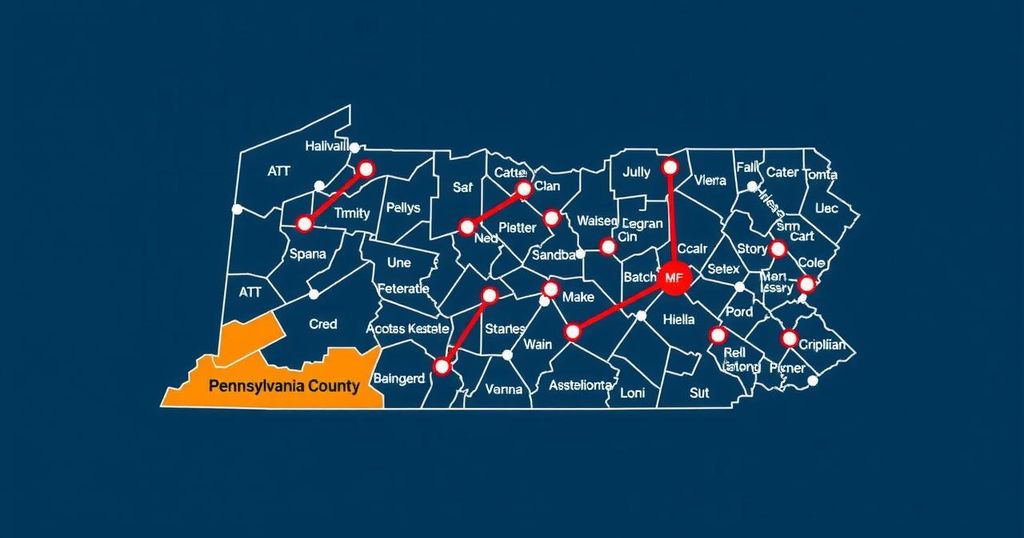Political Division in Bucks County: Residents Seek Resolution Amidst Election Season
Bucks County, Pennsylvania, serves as a microcosm of the national political divide, featuring polarized support for Donald Trump and Kamala Harris. Voters express a strong reluctance to engage in political discussions, highlighting the uncomfortable atmosphere during the election season. Democratic leaders aim for enhanced voter turnout while dealing with ongoing economic apprehensions among constituents. The county’s historical voting patterns further complicate predictions for the upcoming election, underscoring crucial dynamics that will shape electoral outcomes.
In Bucks County, Pennsylvania, a significant yet subdued battleground for the upcoming presidential election is taking shape. The political landscape is distinctly polarized, with strong support for both former President Donald Trump and Vice President Kamala Harris. Despite the clear division among voters, discussions surrounding politics are notably scarce, with many constituents expressing a desire to move past the contentious election season. On the quaint streets of Newtown, adorned with autumn decorations and Halloween festivities, a Trump supporter, who preferred to remain anonymous, highlighted the difficulties of political discourse in the community. He expressed concern about the repercussions of political disagreements on business interactions, demonstrating the pervasive desire among residents to avoid controversy: “You don’t really hear people talking about politics. And I won’t talk about it with my customers… It’s definitely not good for business.” Historically, Bucks County has swung between party loyalties, with Hillary Clinton narrowly winning the county by around 2,000 votes in 2016 and President Biden surpassing Trump by more than 17,000 votes in 2020. Steve Santarsiero, a Democratic state senator, acknowledged the unpredictable nature of the electoral outcome, remarking on the potential for Kamala Harris to surpass Biden’s performance, though he remained cautious about her chances. “I think she could win,” he concluded, embodying the hopes of Democratic campaigners amidst uncertainty. To bolster voter turnout, Democratic leaders are focused on ensuring that mail-in ballots are returning after observing a concerning trend where approximately 10,000 ballots went unreturned in the last election. The sentiments of constituents reflect a current preoccupation with economic stability, with issues extending beyond inflation, as residents express apprehensions tied to emerging technologies such as artificial intelligence impacting traditional job markets. On the Republican side, supporters cited a range of grievances against the current administration, particularly concerning economic performance and immigration policies. A local contractor articulated his disdain succinctly, condemning the administration’s handling of various national issues: “Everything… prices are high, the economy is shit, and the border — that right there is enough reason that she shouldn’t get four more years.” The political landscape in Bucks County is not only marred by division but also affects interpersonal relationships, as individuals from both parties revealed their reluctance to engage in political debates with friends and family. One Harris supporter emphasized the moral imperative driving her vote, saying, “Harris is for something that’s wholesome and good. That’s what we need right now.” Meanwhile, the coexistence of competing campaign signs along local streets symbolically illustrated the tension and disagreement amidst the seasonal beauty of Pennsylvania’s autumn. In this backdrop of vying political ideologies, the community displays a shared desire for resolution and a reduction in the vitriol dominating current political narratives, hinting at the complex interplay between local sentiments and national elections.
Bucks County, a critical area in Pennsylvania’s political landscape, is characterized by a significant divide between supporters of Donald Trump and Kamala Harris. Historically fluctuating between party affiliations, the county’s electoral outcomes have been influenced by both local concerns and national trends, including economic issues, social movements, and the repercussions of pivotal Supreme Court decisions. As the election approaches, efforts from the Democratic Party focus on maximizing voter turnout, particularly from mail-in ballots, underscoring the importance of every vote in a tightly contested battleground state.
The upcoming presidential election in Bucks County highlights a deeply divided electorate, each side harboring strong feelings about their candidates while simultaneously exhibiting an aversion to engage in political discourse. The balancing act of maintaining business relationships and personal convictions underscores a prevailing desire among residents to transcend the contentious atmosphere of modern politics. As efforts intensify to mobilize voter engagement, the outcome remains uncertain, encapsulating the unpredictable and often turbulent nature of American electoral politics.
Original Source: rollcall.com




Post Comment